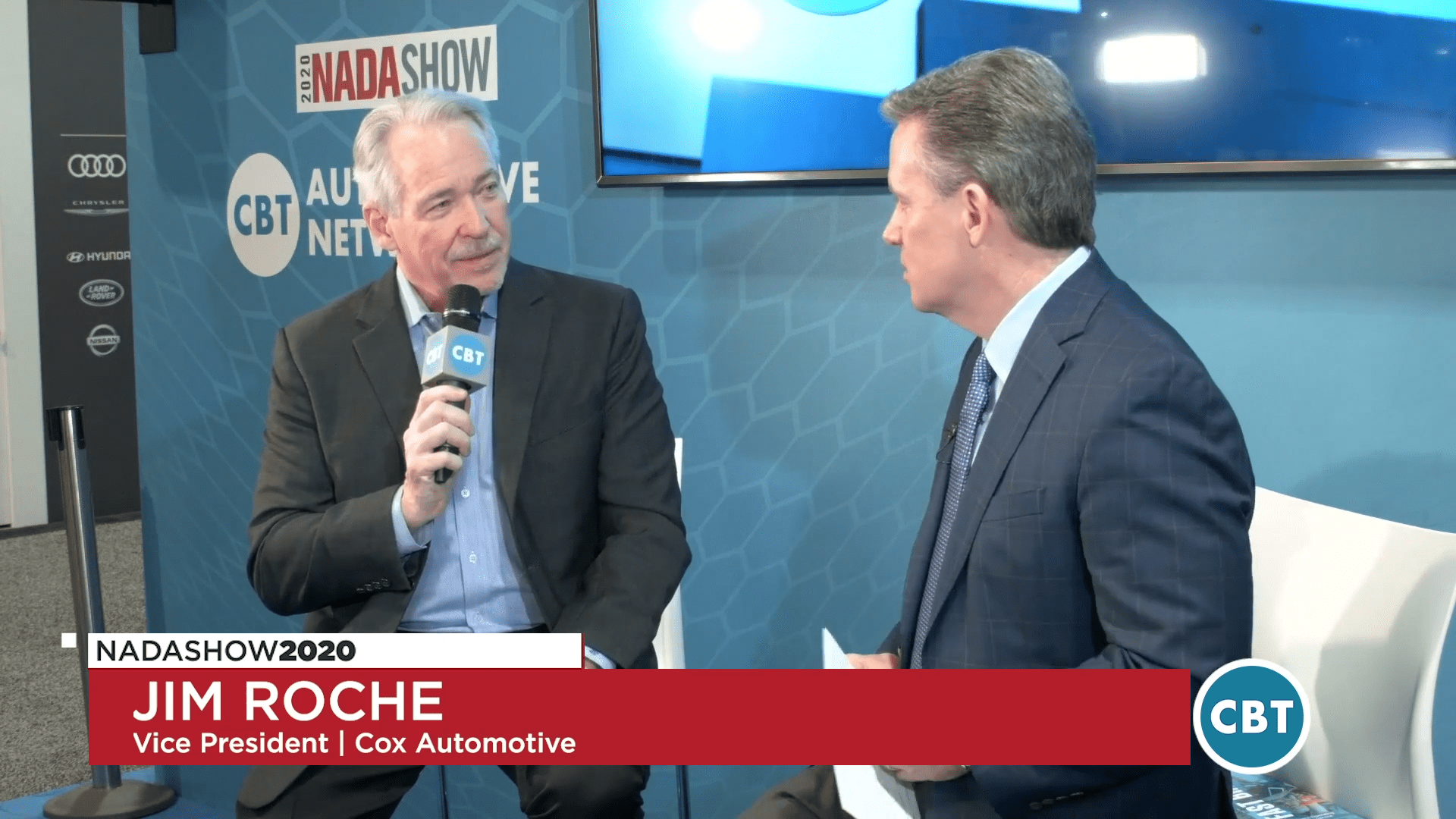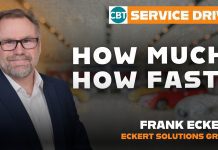Vice President for Cox Automotive, Jim Roche joined Jim Fitzpatrick on the CBT Stage at NADA 2020 in Las Vegas to discuss the new chapter of his book Fast Break, the new Kelley Blue Book Featured Auto Repair Center, and how to increase fixed-ops profitability.


Jim Fitzpatrick: Fix ops continues to be a key dealer profitability center. What strides have dealers been making in this area?
Jim Roche: Over the last couple of years you see a lot of dealers’ strides. According to NADA in 2018 49.6% of total dealership gross profit came from fixed operations. So call it half. And that’s been steadily rising. Not surprising because it’s getting harder and harder to make money on cars, especially new cars.
Jim Fitzpatrick: That’s true. That’s true.
Jim Roche: So I think what we’re, generally, what we’re seeing is that dealers are paying more attention to the customer. You see more investment in technology to provide a great technology enhanced experience. And that’s what we want. We manage our lives through our technology now and we’d like to manage our automotive life the same way. So I think that’s a key.
Jim Fitzpatrick: And consumers want that. The consumers want that connection too. To their dealer in fixed ops and their smartphone or what have you.
Jim Roche: You just mentioned you tried to change a flight on the way back. You were using your phone.
Jim Fitzpatrick: Yes I was.
Jim Roche: Restaurant reservation. I wanted to get a ride someplace. Exactly.
Jim Fitzpatrick: There’s no question. You added a new chapter to the book, Fast Break. Talk to us. Why a new chapter? Why now?
Jim Roche: Yeah, that’s a good question. So when I introduced Fast Break, it’s essentially how to become more customer centric and improve loyalty in the service department. But since we wrote that, a couple of interesting facts emerged. By year five of ownership, we know that 71% of customers have defected from dealership service. And when you ask those kind, I know, 29% is retained.
Jim Fitzpatrick: That’s crazy.
Jim Roche: That is crazy. And it’s dangerous for us. If you ask that 71% that has defected, “Why?” of the top five reasons, four have to do with service pricing. They essentially say it’s too expensive. But when you look at service pricing, it’s not more expensive.
Jim Fitzpatrick: All the dealers that are listening right now are going, “More expensive? What do you–”
Jim Roche: No, dealers are competitive. All the data shows that, so why are they saying it’s more expensive? It’s not. So it’s fundamentally is two things. Dealerships have an awareness problem. Consumers don’t know they’re competitive. But underneath that dealerships have a trust problem. And that’s complicated. Maybe past business practices, maybe Mike Wallace on 60 minutes.
Jim Fitzpatrick: Just the overall industry itself?
Jim Roche: The independent service centers have done a great job for decades and saying, “Dealer service bad. Come to us,” and it’s not many more. But regardless of the reason, there’s a fundamental trust problem, and that’s what I highlight in the new chapter and try and draw some recommendations of how we can combat that.
Jim Fitzpatrick: That’s with the new KBB Featured Auto Repair Center. Talk to us about that, cause that’s actually helping dealers to build that trust and helping consumers to trust the dealers better.
Jim Roche: That’s exactly right.
Jim Fitzpatrick: Talk to us about that.
Jim Roche: Well I met Cox, Cox automotive. I was asked to go over in KBB in April 2019 to see what we could do in service. And KBB is the most trusted automotive brand, consumer facing third party.
Jim Fitzpatrick: I know. It’s incredible.
Jim Roche: Oh 18 million consumers a month come to KBB.com. I know. We’ve been around almost a hundred years, so it really is just synonymous with trust and with prices. So what we felt we could do and what we built in Featured Auto Repair Center is if you’re a consumer, you know that vehicles have a ton of technology in them, and they’re really complicated.
Jim Fitzpatrick: That’s right.
Jim Roche: And that creates anxiety, cause we’re not sure what to do. But if you scrape away the technobabble, there’s four fundamental questions. Tell me what I need to do, when I need to do it, who’s qualified to do it, and about what should it cost.
Jim Fitzpatrick: Makes sense.
Jim Roche: So we took that knowledge and we answer those four questions at KBB in Featured Auto Repair Center. And then we give the consumer the ability to click and schedule an appointment with a franchise dealer to get their service done. But what we’ve done is as the consumer is doing their research in much in the same way that KBB, if you’re going to buy or sell a car, it should be between 31,000 and 33,000. If you go in and you say, “I have a 2016 Chevrolet Camaro, and I need an oil change” we’ll say that should be between $56 and $70. So we’re giving a KBB fair repair range for service, and now you can make that appointment with the dealer.
Jim Fitzpatrick: And levels the playing field for the consumer and it puts the dealer back on the field.
Jim Roche: That’s exactly right.
Jim Fitzpatrick: In terms of competition, right?
Jim Roche: Exactly. Well, I mean before if I told you, “You need brake pads, and that’s $400” you didn’t know if that was a great price, not a great price. You had no, unless you did a bunch of research.
Jim Fitzpatrick: Funny you should say that because I just had a brake job done on my SUV and it hit me at $850. They said, “Oh, the rotors need to,” they do the whole rotor thing and not to take it away from dealers, but you don’t know. You just don’t. And I don’t even know if that job is a high job, a low job. I don’t know what the deal is.
Jim Roche: But if you had gone to KBB and typed your year, make, and model in and looked that up, it would have said, “In your market area,” because we did it geographically, “here is about what you should pay.” I was just talking to a BMW dealer group from New Jersey and the dealer leader, and he had his service leaders there and he said, “I pulled it up and it said you should pay between 173 and 195,” and he said, “what do we charge?” And he said, “189.” So I was like-
Jim Fitzpatrick: Dead center.
Jim Roche: See? You know why? What we did is we pulled 200 million repair orders and we analyzed from dealers and we did the real dealer prices. This isn’t estimations, this isn’t extrapolated from labor time guides. It’s real dealer prices. So I feel pretty good that it’s going to be accurate.
Jim Fitzpatrick: Hey, talk to us, and thanks for all the time you’ve given us today, but talk to us about the marketing efforts. What should fixed ops or dealers focus on for their marketing in 2020 with regard to fix ops?
Jim Roche: Sure, well I think number one, I think if you’re going to create that trust obviously, and I in the new chapter in the book I outlined, you can use a third party to do it, or you can do it yourself. But we need to be working on bridging that trust gap. The other thing I think we need to do that is sort of related to this is we really needed to focus this service on price transparency. If you transact anything online, right? You want to know three things. Tell me what I need, where I can get it, and what does it cost? Anything you buy online tells you that. Amazon started that. So we’ve got to get prices online. Not just an oil change, not just a tune up on an oil change. Get as many of your prices–
Jim Fitzpatrick: Should that be on a dealer’s website?
Jim Roche: Absolutely. Absolutely. It should be on your website. It should be in your service marketing. It should be on your menus in the service drive. Go with price transparency-
Jim Fitzpatrick: And what’s great-
Jim Roche: So the consumers know you’re competitive.
Jim Fitzpatrick: That’s right. That’s right. And what’s good about that too is that when a dealer or when a consumer gets a estimate or an estimate from a dealer, they can go right on the dealer’s website to see if that kind of marries up to the same pricing.
Jim Roche: Precisely-
Jim Fitzpatrick: You know what I mean? Because that customer, that sense of, okay, this service advisor is right in line with what they have on their website.
Jim Roche: Right. And then that lifts that trust. Then they go back to you more frequently. And here’s one you and I’ve talked about before, but if somebody visited for service once in the last 12 months, and you’re looking to buy another car, they’re 74% likely to come back to you. But if they haven’t visited for service in the last 12 months, only 35%. 74%. 35%.
Jim Fitzpatrick: That’s crazy.
Jim Roche: So start with price transparency to get them back for service and you’ll sell more cars.








